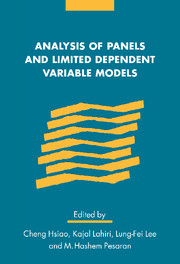Book contents
- Frontmatter
- Contents
- List of contributors
- Foreword
- Introduction
- 1 A note on left censoring
- 2 Autoregressive models with sample selectivity for panel data
- 3 Mixture of normals probit models
- 4 Estimation of dynamic limited-dependent rational expectations models
- 5 A Monte Carlo study of EC estimation in panel data models with limited dependent variables and heterogeneity
- 6 Properties of alternative estimators of dynamic panel models: an empirical analysis of cross-country data for the study of economic growth
- 7 Modified generalized instrumental variables estimation of panel data models with strictly exogenous instrumental variables
- 8 Expectations of expansions for estimators in a dynamic panel data model: some results for weakly exogenous regressors
- 9 Re-examining the rational expectations hypothesis using panel data on multi-period forecasts
- 10 Prediction from the regression model with one-way error components
- 11 Bayes estimation of short-run coefficients in dynamic panel data models
- 12 Bias reduction in estimating long-run relationships from dynamic heterogeneous panels
- CV of G.S. Maddala
- Index
6 - Properties of alternative estimators of dynamic panel models: an empirical analysis of cross-country data for the study of economic growth
Published online by Cambridge University Press: 22 September 2009
- Frontmatter
- Contents
- List of contributors
- Foreword
- Introduction
- 1 A note on left censoring
- 2 Autoregressive models with sample selectivity for panel data
- 3 Mixture of normals probit models
- 4 Estimation of dynamic limited-dependent rational expectations models
- 5 A Monte Carlo study of EC estimation in panel data models with limited dependent variables and heterogeneity
- 6 Properties of alternative estimators of dynamic panel models: an empirical analysis of cross-country data for the study of economic growth
- 7 Modified generalized instrumental variables estimation of panel data models with strictly exogenous instrumental variables
- 8 Expectations of expansions for estimators in a dynamic panel data model: some results for weakly exogenous regressors
- 9 Re-examining the rational expectations hypothesis using panel data on multi-period forecasts
- 10 Prediction from the regression model with one-way error components
- 11 Bayes estimation of short-run coefficients in dynamic panel data models
- 12 Bias reduction in estimating long-run relationships from dynamic heterogeneous panels
- CV of G.S. Maddala
- Index
Summary
Introduction
One of the most important implications of the classic papers of Solow (1956) and Swan (1956) is that the lower the starting level of real per capita GDP, relative to the long run of steady state position, the faster is the growth rate. The Solow–Swan model assumes a constant-returns-to-scale production function with two inputs, capital and labor, and substitution between inputs, a constant savings rate, constant rate of growth of population, and neutral technical change, all exogenously given. Convergence of economies starting out at different levels of per capita income to the same steady state rate of growth refflects the diminishing returns to capital implied by the production function assumed: economies starting out with lower levels of real per capita GDP relative to the long-run or steady state position have less capital per worker and therefore higher rates of return to capital. I will refer to this as the standard Barro-Baumol (BB) sense of the meaning of convergence. There is a good deal of current discussion regarding the appropriate deffinition of “convergence.” My purpose here is not to question this notion of convergence but rather to show that estimates of the coefficient of the lagged dependent variable in a dynamic panel model which has been used to study this phenomenon are extremely sensitive to the method of estimation employed.
- Type
- Chapter
- Information
- Analysis of Panels and Limited Dependent Variable Models , pp. 136 - 170Publisher: Cambridge University PressPrint publication year: 1999
- 12
- Cited by



